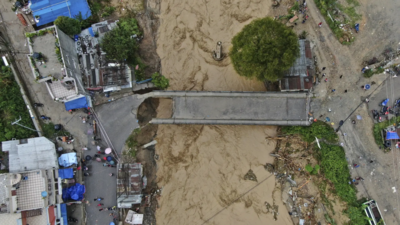[ad_1]

Nepal on Monday began to assess the damage caused by the catastrophic floods and landslides on Monday. The heavy rain wreaked havoc in the country claiming the lives of 200 people. Around 32 were missing in two days of incessant rains that were caused by the low-pressure system in the Bay of Bengal, according to a report from AP.
The disaster has left residents with the challenging task of cleaning their homes and retrieving their damaged belongings from the mud.
In the northern regions of Bangladesh, which are separated from Nepal by a narrow strip of Indian land, over 100,000 people have been left stranded due to heavy rainfall and the influx of water from upstream areas.
The Kathmandu Valley, home to four million people and the capital city, suffered one of its worst devastations in recent years, with 56 deaths reported. Rivers overflowed their banks, inundating homes, hospitals, roads, bridges, and markets.
Prithvi Subba Gurung, a senior minister and cabinet spokesperson, said that the government is currently evaluating the extent of the damage and the cost of rebuilding efforts. Some weather stations in Kathmandu recorded the highest 24-hour rainfall in decades, according to officials.
Surya Raj Acharya, an infrastructure and urban planning expert, attributed the extensive damage to uncontrolled construction and urbanization in Kathmandu without proper engineering and planning considerations.
“River banks are encroached by people for construction of houses, ignoring the basic enforcement of engineering and planning, without provisions for drainage and sewage system,” he said.
Acharya emphasised the need to consider Nepal’s geography, terrain, river systems, monsoon patterns, and the potential for extreme climate events when planning for such situations. Climate scientists, such as Arun Bhakta Shrestha from the International Centre for Integrated Mountain Development (ICIMOD), also highlighted the significant role of climate change in exacerbating the disaster, which was further compounded by poor urban planning and infrastructure.
In Bangladesh, vast areas of land in five northern districts have been submerged following the sudden swelling of the Teesta River, which has crossed its danger mark at several points. The rising waters have devastated large areas of farmland, washing away crops such as paddy and vegetables, along with fish farms, leaving many farmers facing severe losses.
Homes, roads, and critical infrastructure have also been inundated, forcing people to seek refuge on higher ground. The situation is expected to worsen in the coming days, with the Bangladesh weather office warning of more rain.
[ad_2]
Source link







